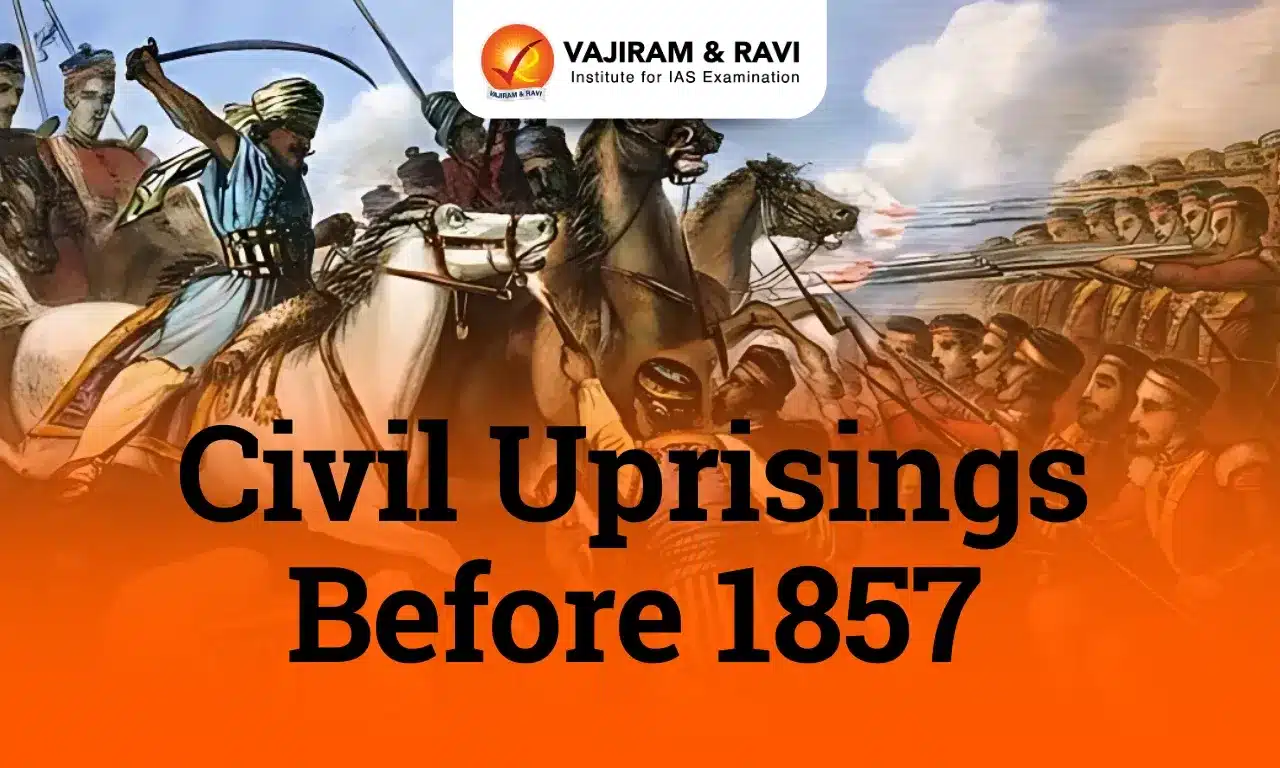Civil Uprisings Before 1857: The colonial rule profoundly impacted all aspects of Indian society. Still, the first was the Indian ruling class and the erstwhile zamindars that bore the brunt of the British conquest. There were several civil uprisings in this period, led by the deposed rulers, ex-officials of conquered Indian states, impoverished zamindars, and feudal lords (poligars). The British policy of subsidiary alliance and discriminatory treatment of Indian sepoys in the army were the primary reasons for these uprisings, further fuelled by their economic policy and land revenue settlements that further sidelined the old order.
These uprisings, however, were local and small in scale and crushed ruthlessly, culminating in a larger revolt called the 1857 Revolt or the First War of Independence.
Major Civil Uprisings Before 1857
After the British started gaining control of northern India post the Battle of Plassey in 1757, there were intermittent public eruptions by the various sections of Indian society for the next hundred years; civil uprisings were one of them. Some of the significant civil uprisings are described below:
| Civil Uprisings Before 1857 | |
| Name of the revolt | Description |
| Revolt by the Raja of Vizianagaram | – Year: July 1794
– Governor-General: John Shore – The Raja of Vizianagaram (modern-day of Andhra Pradesh) openly declared war on the British. – Reason for the revolt: British reduced the area of his zamindari and increased the revenue payable to the British.
– British Reaction: In an encounter with the British forces. Raja was killed along with his 300 armed men.
|
| Vellore Mutiny | – Year: 1806
– Area: Tamil Nadu – Governor–General: George Barlow – Under British rule, the Indian military garrison of Madras was stationed in the fort of Vellore (Tamil Nadu),which became the site of the famous Vellore mutiny of 1806 CE. – Reason for the revolt: In 1805 CE, the sepoys were given a new dress code in which they were not allowed to show any caste markings, had to trim their beards and moustaches, and had to remove their turbans. This was done to “improve” the regiment’s “soldierly appearance’’.
– The Vellore mutiny was precipitated by these unjust and offensive changes, as well as the brutal treatment meted out to any voice of dissent within the fort. – British reaction: As the sepoys revolted, a British officer, Major Coopes, escaped and alerted the Arcot garrison.
|
| Dewan Velu Thambi Revolt | – Year: 1808-09
– Area: Travancore state (includes several southern districts of modern-day Kerala) – Governor General: Lord Minto I – Reason for the revolt:
– British Reaction: Despite the support of the neighbouring state of Cochin, Thambi was defeated by the British. He died of serious injuries after Trivandrum (the capital of Travancore) fell into British hands in 1809. |
| Kutch Rebellion | – Year: 1816-1832
– Reason for the revolt: British signed a treaty in 1816 with Maharaja Bharamal II of Kutch, granting throne power but interfering in Kutch’s internal affairs.
– The trouble erupted again in 1831. – British reaction: After extensive military operations failed to control the situation, the Company’s leaders were forced to adopt a more conciliatory approach. |
| Paika Rebellion | – Year: 1817
– Area: Odisha – The Paikas were peasant militias of Odisha’s Gajapati rulers who provided military assistance to the king. – Reason for the revolt: When the British established new colonial establishments and land revenue settlements, the Paikas lost their estates.
– Nature of the revolt: A large number of Paikas were mobilised under Bakshi Jagabandhu Bidyadhar’s leadership, who then confronted the British on April 2, 1817. – From Ghumsur, a 400-strong Kandha party crossed into Khurda and declared rebellion. – The uprising spread like wildfire throughout the state, resulting in several clashes and encounters between British and Paika forces. – Government offices in Banapur were set on fire, police officers were killed, and the British treasury was looted. – British reaction: The revolt raged on for several months before being crushed by the British army. Bidyadhar was imprisoned in 1825 and died in prison four years later. |
| Waghera rising | – Year: 1818-1820
– Area: Baroda, Gujarat – Reason for the revolt: The Waghera chief was forced to take up arms after the Gaekwar of Baroda was fortified by the British Regime. – The Wagheras carried on inroads into British territory during 1818-19. – British Reaction: A peace treaty was concluded in November 1820. |
| Satara Revolt | – Year: 1840
– Area: Satara, Maharashtra – Leaders: Dhar Rao Pawar and Narasingh Dattatreya Petkar. – Governor-General: Lord Auckland – Reason for the revolt: This uprising was caused as a result of the British deposition of Chhatrapati Pratapsingh in 1839 when he attempted to assert his sovereignty and territorial rights and exiled him to Varanasi.
– They gathered over a thousand men for the uprising and attacked the Badami Fort. – The insurgents successfully captured the stronghold and raised the Satara flag on its ramparts. – British reaction: The British retaliated promptly with a strong-armed force and captured the fort quickly. – Petkar and his colleagues were found guilty and sentenced to life in prison. – Dhar Rao Pawar remained active in the Shirala Mahal and Karad regions for several years, resisting the British. The uprising, however, was finally put down in 1844. |
| Gadkari Revolt | – Year: 1844
– Area: Kolhapur, Maharashtra – Governor-General: Lord Ellenborough – Reason for the revolt: When the British occupied Satara, they extensively took over the lands of the region, particularly of the agrarian Maratha–militia, the Gadkaris. – Nature of the revolt: They took over the Samangarh and Bhudargarh forts and rose against the British troops at Kolhapur by setting up a parallel government in the state. – British Reaction: The Revolt was eventually curbed by the British army. |
| Surat Salt Agitation | – Year: 1844
– Area: Surat, Gujarat – Reason for the revolt: Salt duty was raised in the Bombay Presidency in the year 1844. This caused considerable excitement among the poorer classes. – Nature of the revolt: They organised demonstrations to submit a petition to express their ‘deep resentment’.
– British Reaction: High officials, after discussions and negotiations, were ‘convinced of the absolute necessity of yielding to the wishes of the people’.
|
Last updated on April, 2025
→ UPSC Notification 2025 was released on 22nd January 2025.
→ The UPSC Vacancy 2025 were released 1129, out of which 979 were for UPSC CSE and remaining 150 are for UPSC IFoS.
→ UPSC Admit Card 2025 is expected to release in first week of May for CSE Prelims Exam 2025.
→ The UPSC Prelims 2025 is scheduled to be conducted on 25th May 2025 and UPSC Mains 2025 will be conducted on 22nd August 2025.
→ Apply once through it and aspirants can apply for various government exams conducted by UPSC.
→ The UPSC Selection Process is of 3 stages-Prelims, Mains and Interview.
→ UPSC Result 2024 is released with latest UPSC Marksheet 2024. Check Now!
→ UPSC Toppers List 2024 is released now. Shakti Dubey is UPSC AIR 1 2024 Topper.
→ Also check Best IAS Coaching in Delhi
















